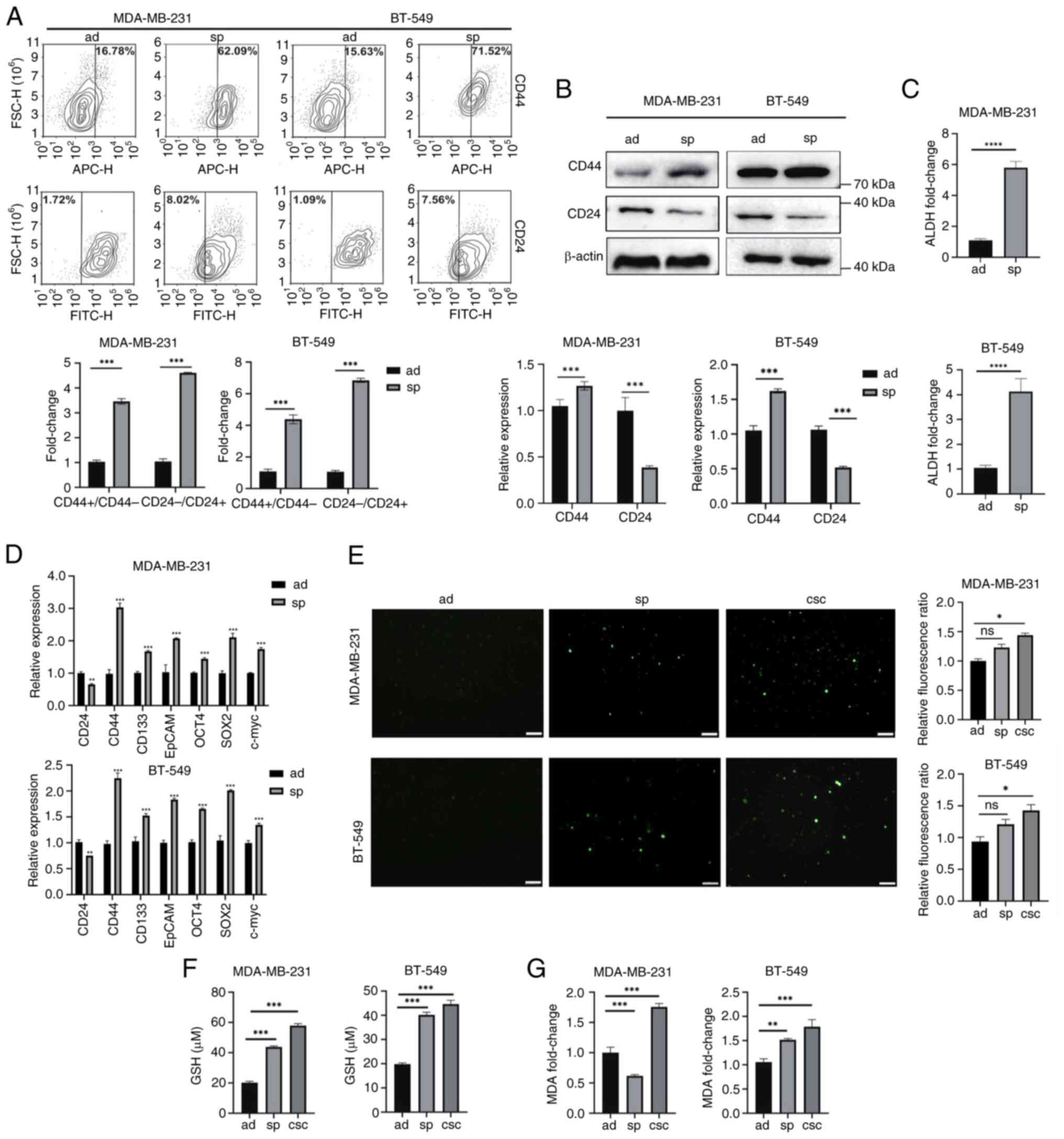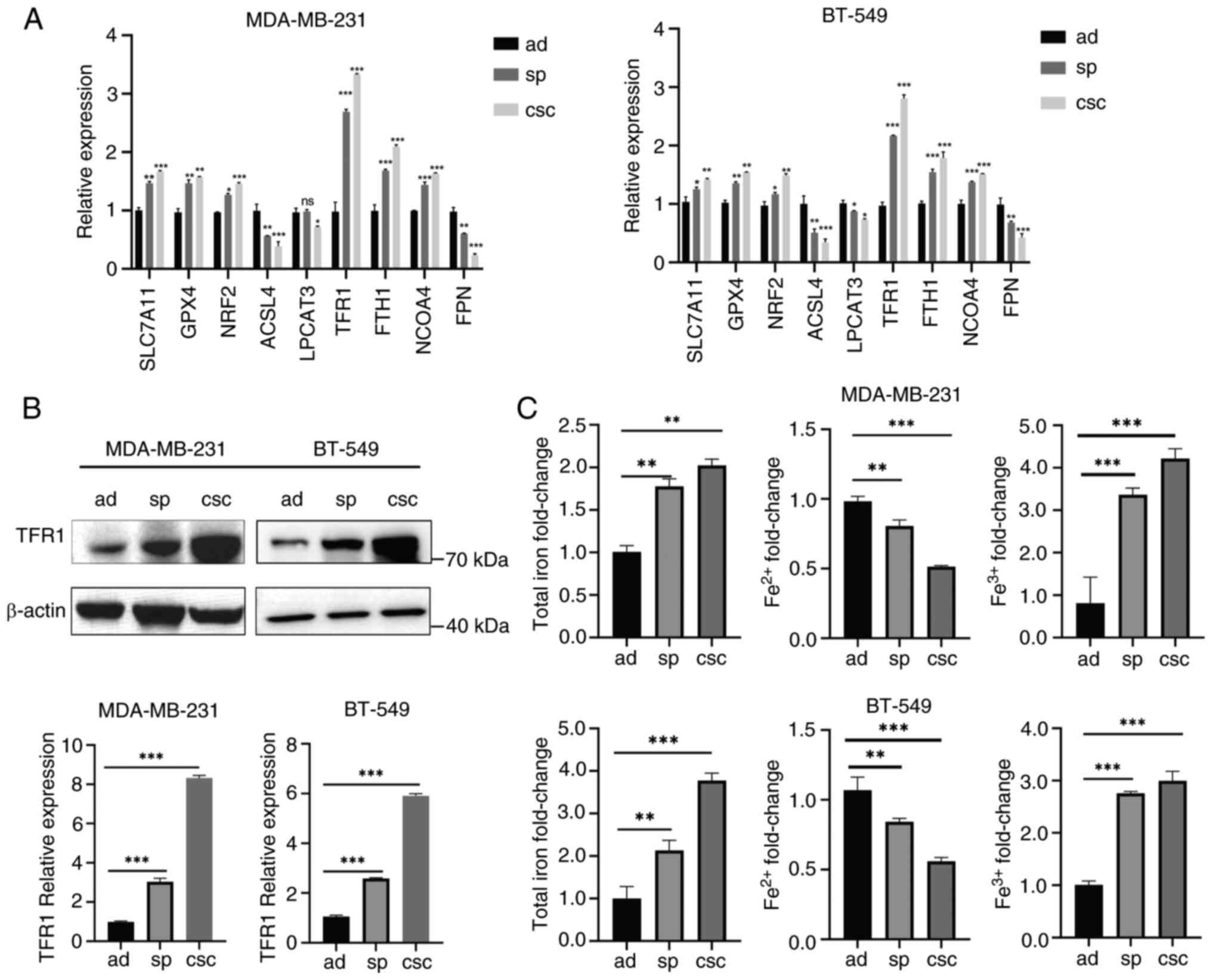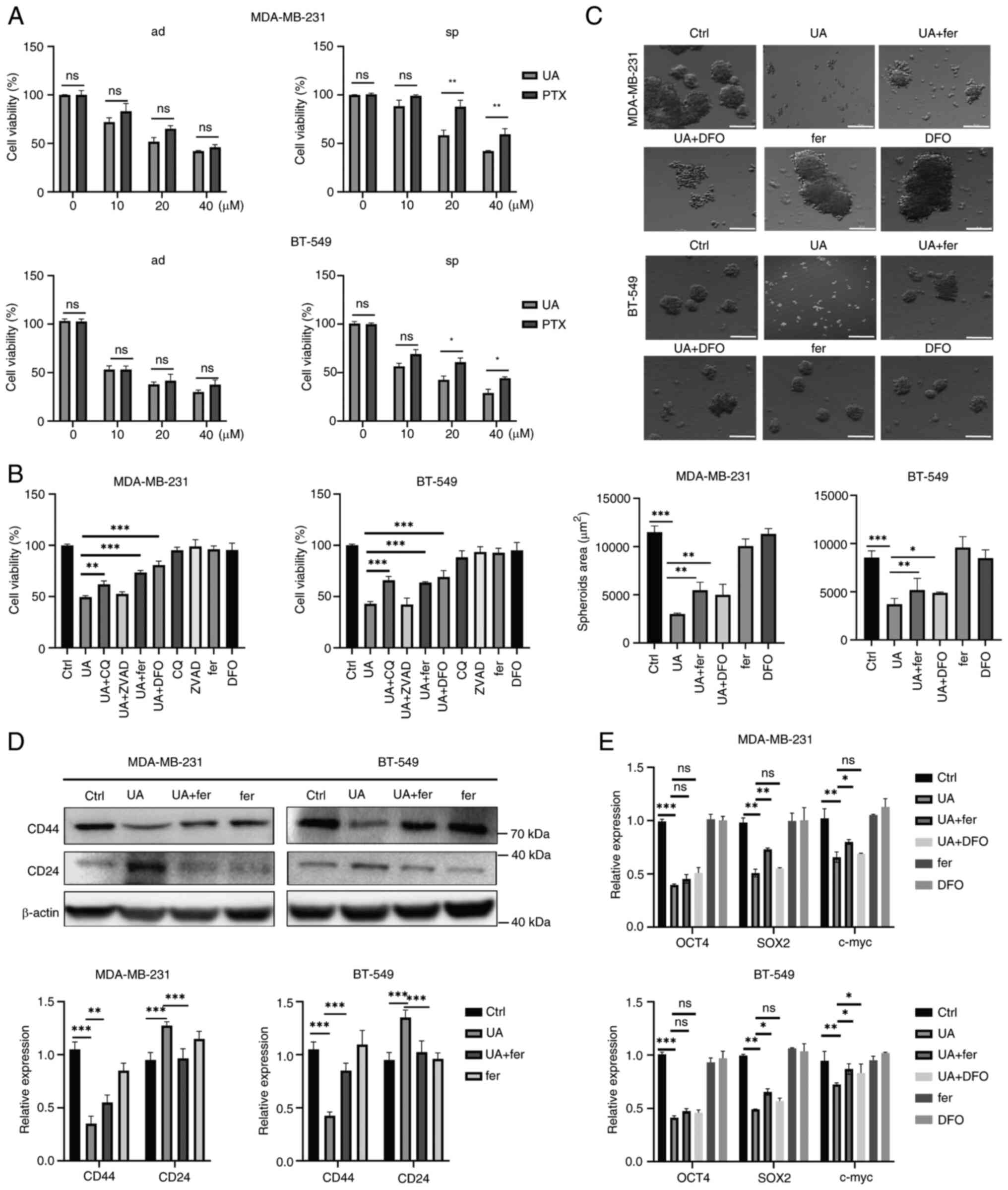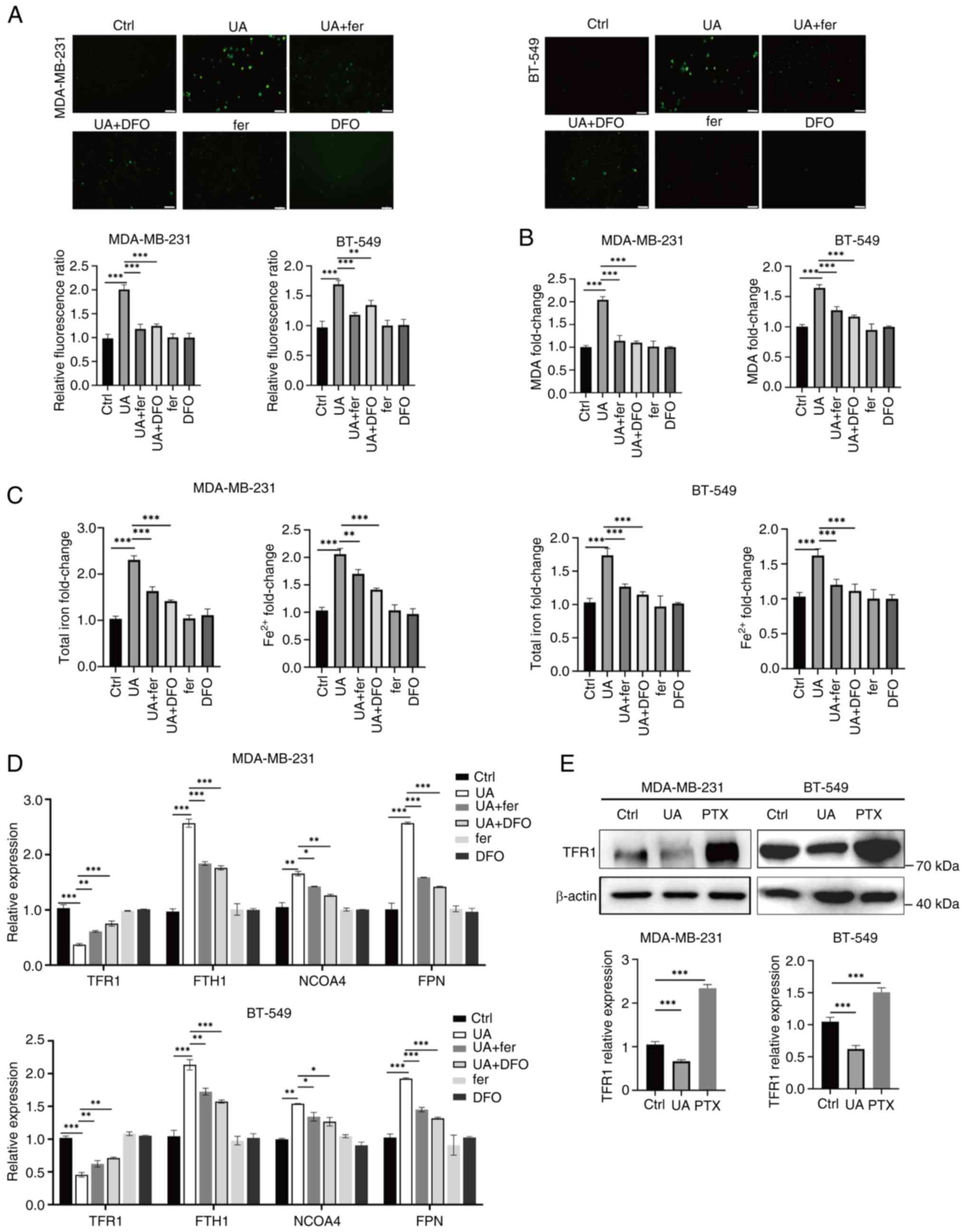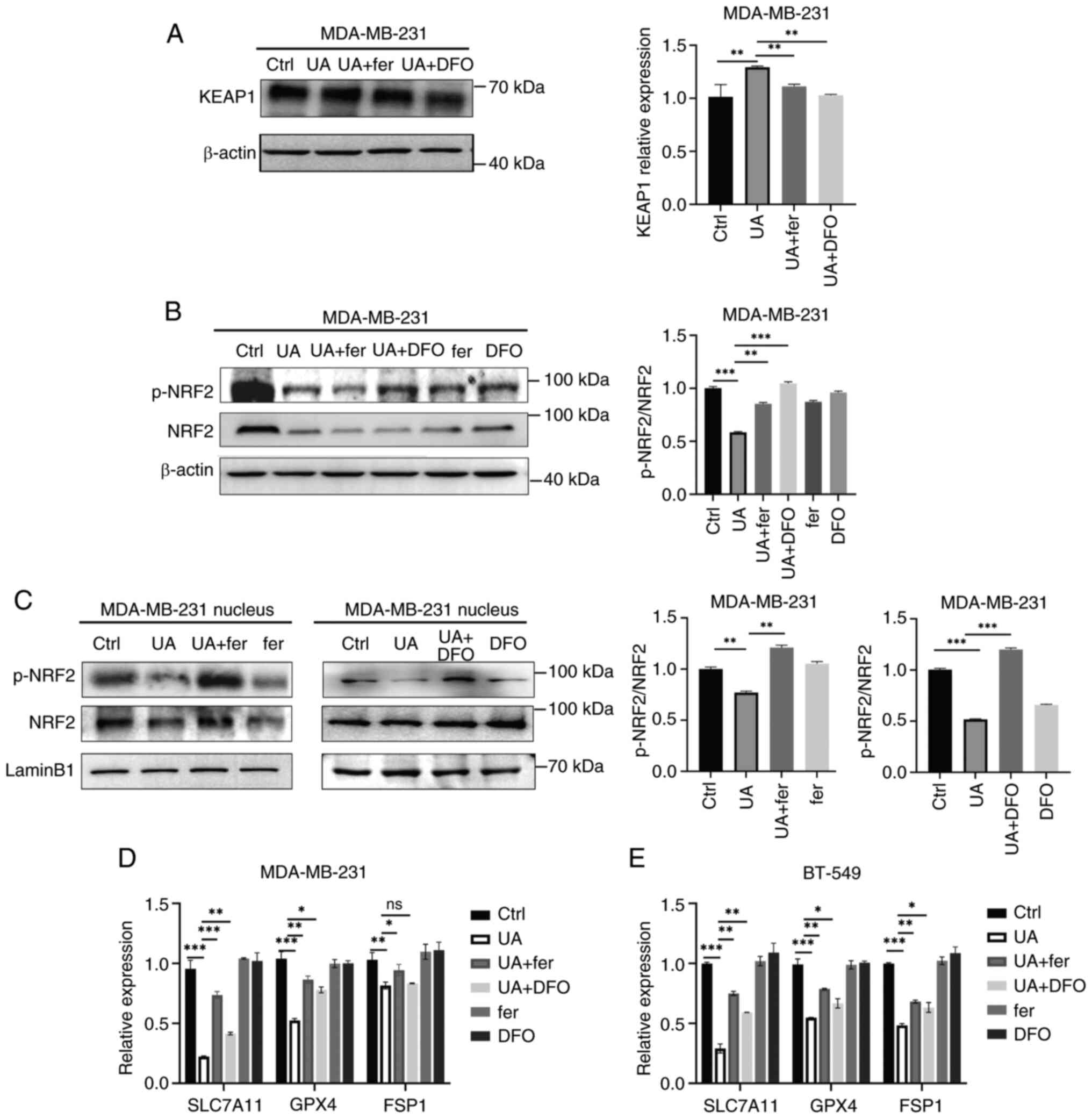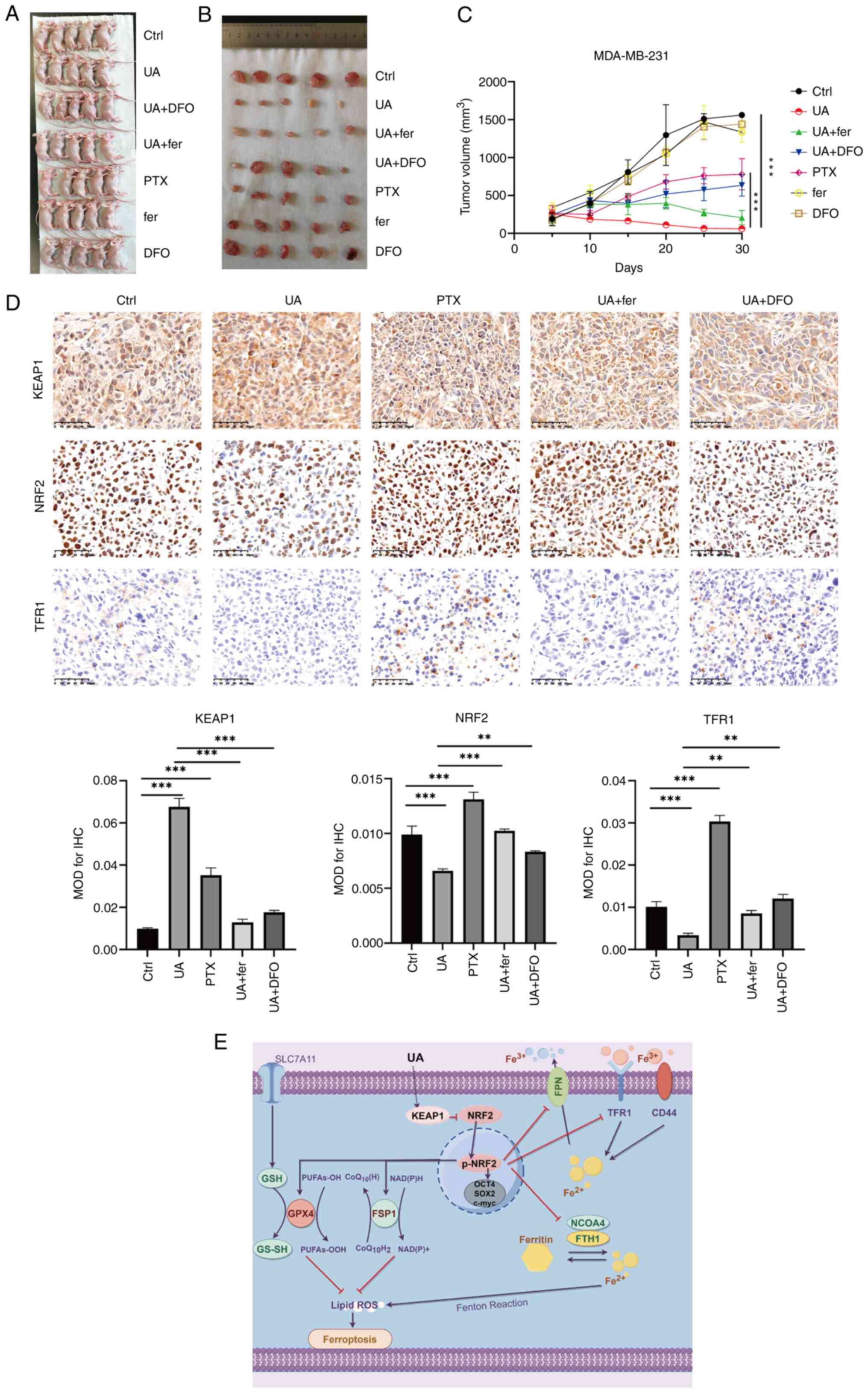|
1
|
Sung H, Ferlay J, Siegel RL, Laversanne M,
Soerjomataram I, Jemal A and Bray F: Global cancer statistics 2020:
Globocan estimates of incidence and mortality worldwide for 36
cancers in 185 countries. CA Cancer J Clin. 71:209–249. 2021.
View Article : Google Scholar : PubMed/NCBI
|
|
2
|
Houghton SC and Hankinson SE: Cancer
progress and priorities: Breast cancer. Cancer Epidemiol Biomarkers
Prev. 30:822–844. 2021. View Article : Google Scholar : PubMed/NCBI
|
|
3
|
Deng H, Muthupalani S, Erdman S, Liu H,
Niu Z, Wang TC and Fox JG: Translocation of Helicobacter hepaticus
synergizes with myeloid-derived suppressor cells and contributes to
breast carcinogenesis. Oncoimmunology. 11:20573992022. View Article : Google Scholar : PubMed/NCBI
|
|
4
|
Sharma P: Biology and management of
patients with triple-negative breast cancer. Oncologist.
21:1050–1062. 2016. View Article : Google Scholar : PubMed/NCBI
|
|
5
|
Hsu JY, Chang CJ and Cheng JS: Survival,
treatment regimens and medical costs of women newly diagnosed with
metastatic triple-negative breast cancer. Sci Rep. 12:7292022.
View Article : Google Scholar : PubMed/NCBI
|
|
6
|
Thiagarajan PS, Sinyuk M, Turaga SM,
Mulkearns-Hubert EE, Hale JS, Rao V, Demelash A, Saygin C, China A,
Alban TJ, et al: Cx26 drives self-renewal in triple-negative breast
cancer via interaction with NANOG and focal adhesion kinase. Nat
Commun. 9:5782018. View Article : Google Scholar : PubMed/NCBI
|
|
7
|
Toledo-Guzmán ME, Bigoni-Ordóñez GD,
Ibáñez Hernández M and Ortiz-Sánchez E: Cancer stem cell impact on
clinical oncology. World J Stem Cells. 10:183–195. 2018. View Article : Google Scholar : PubMed/NCBI
|
|
8
|
Lin X, Wang Y, Fang K, Guo Z, Lin N and Li
L: The application of nanoparticles in theranostic systems
targeting breast cancer stem cells: Current progress and future
challenges. Stem Cell Res Ther. 14:3562023. View Article : Google Scholar : PubMed/NCBI
|
|
9
|
Liu S, Cong Y, Wang D, Sun Y, Deng L, Liu
Y, Martin-Trevino R, Shang L, McDermott SP, Landis MD, et al:
Breast cancer stem cells transition between epithelial and
mesenchymal states reflective of their normal counterparts. Stem
Cell Reports. 2:78–91. 2013. View Article : Google Scholar : PubMed/NCBI
|
|
10
|
Jiang X, Stockwell BR and Conrad M:
Ferroptosis: Mechanisms, biology and role in disease. Nat Rev Mol
Cell Biol. 22:266–282. 2021. View Article : Google Scholar : PubMed/NCBI
|
|
11
|
Cosialls E, El Hage R, Dos Santos L, Gong
C, Mehrpour M and Hamaï A: Ferroptosis: Cancer stem cells rely on
iron until ‘to die for’ It. Cells. 10:29812021. View Article : Google Scholar : PubMed/NCBI
|
|
12
|
Torti SV and Torti FM: Iron and cancer:
More ore to be mined. Nat Rev Cancer. 13:342–355. 2013. View Article : Google Scholar : PubMed/NCBI
|
|
13
|
Mai TT, Hamaï A, Hienzsch A, Cañeque T,
Müller S, Wicinski J, Cabaud O, Leroy C, David A, Acevedo V, et al:
Salinomycin kills cancer stem cells by sequestering iron in
lysosomes. Nat Chem. 9:1025–1033. 2017. View Article : Google Scholar : PubMed/NCBI
|
|
14
|
Pandrangi SL, Raju Bagadi SA, Sinha NK,
Kumar M, Dada R, Lakhanpal M, Soni A, Malvia S, Simon S, Chintamani
C, et al: Establishment and characterization of two primary breast
cancer cell lines from young Indian breast cancer patients:
Mutation analysis. Cancer Cell Int. 14:142014. View Article : Google Scholar : PubMed/NCBI
|
|
15
|
Anandhan A, Dodson M, Schmidlin CJ, Liu P
and Zhang DD: Breakdown of an ironclad defense system: The critical
role of NRF2 in mediating ferroptosis. Cell Chem Biol. 27:436–447.
2020. View Article : Google Scholar : PubMed/NCBI
|
|
16
|
Sun S, Shen J, Jiang J, Wang F and Min J:
Targeting ferroptosis opens new avenues for the development of
novel therapeutics. Signal Transduct Target Ther. 8:3722023.
View Article : Google Scholar : PubMed/NCBI
|
|
17
|
Zafar S, Khan K, Hafeez A, Irfan M,
Armaghan M, Rahman AU, Gürer ES, Sharifi-Rad J, Butnariu M, Bagiu
IC, et al: Ursolic acid: A natural modulator of signaling networks
in different cancers. Cancer Cell Int. 22:3992022. View Article : Google Scholar : PubMed/NCBI
|
|
18
|
Zhang Y, Ma X, Li H, Zhuang J, Feng F, Liu
L, Liu C and Sun C: Identifying the effect of ursolic acid against
triple-negative breast cancer: Coupling network pharmacology with
experiments verification. Front Pharmaco. 12:6857732021. View Article : Google Scholar : PubMed/NCBI
|
|
19
|
Zong L, Cheng G, Zhao J, Zhuang X, Zheng
Z, Liu Z and Song F: Inhibitory effect of ursolic acid on the
migration and invasion of doxorubicin-resistant breast cancer.
Molecules. 27:12822022. View Article : Google Scholar : PubMed/NCBI
|
|
20
|
Mandal S, Gamit N, Varier L, Dharmarajan A
and Warrier S: Inhibition of breast cancer stem-like cells by a
triterpenoid, ursolic acid, via activation of Wnt antagonist, sFRP4
and suppression of miRNA-499a-5p. Life Sci. 265:1188542021.
View Article : Google Scholar : PubMed/NCBI
|
|
21
|
Li H, Yu Y, Liu Y, Luo Z, Law BYK, Zheng
Y, Huang X and Li W: Ursolic acid enhances the antitumor effects of
sorafenib associated with Mcl-1-related apoptosis and
SLC7A11-dependent ferroptosis in human cancer. Pharmacol Res.
182:1063062022. View Article : Google Scholar : PubMed/NCBI
|
|
22
|
Workman P, Aboagye EO, Balkwill F, Balmain
A, Bruder G, Chaplin DJ, Double JA, Everitt J, Farningham DAH,
Glennie MJ, et al: Guidelines for the welfare and use of animals in
cancer research. Br J Cancer. 102:1555–1577. 2010. View Article : Google Scholar : PubMed/NCBI
|
|
23
|
Stevens MF, Hickman JA, Langdon SP, Chubb
D, Vickers L, Stone R, Baig G, Goddard C, Gibson NW, Slack JA, et
al: Antitumor activity and pharmacokinetics in mice of
8-carbamoyl-3-methyl-imidazo[5,1-d]-1,2,3,5-tetrazin-4(3H)-one
(CCRG 81045; M & B 39831), a novel drug with potential as an
alternative to dacarbazine. Cancer Res. 47:5846–5852.
1987.PubMed/NCBI
|
|
24
|
Yates AG, Weglinski CM, Ying Y, Dunstan
IK, Strekalova T and Anthony DC: Nafamostat reduces systemic
inflammation in TLR7-mediated virus-like illness. J
Neuroinflammation. 19:82022. View Article : Google Scholar : PubMed/NCBI
|
|
25
|
Sun N, Zhang RX, Wang Y, Huang ZJ, Han J,
Bao YS, Duan WY, Dong CR, Deng GS and Zhuang G: Effects of ursolic
acid on oxidative stress and inflammatory factors in a rat model of
AR after PM2.5 exposure. Zhonghua Er Bi Yan Hou Tou Jing Wai Ke Za
Zhi. 57:860–867. 2022.(In Chinese). PubMed/NCBI
|
|
26
|
Innocenti F, Danesi R, Di Paolo A, Agen C,
Nardini D, Bocci G and Del Tacca M: Plasma and tissue disposition
of paclitaxel (taxol) after intraperitoneal administration in mice.
Drug Metab Dispos. 23:713–717. 1995.PubMed/NCBI
|
|
27
|
Dixon SJ, Lemberg KM, Lamprecht MR, Skouta
R, Zaitsev EM, Gleason CE, Patel DN, Bauer AJ, Cantley AM, Yang WS,
et al: Ferroptosis: An iron-dependent form of nonapoptotic cell
death. Cell. 149:1060–1072. 2012. View Article : Google Scholar : PubMed/NCBI
|
|
28
|
Tang G, Chen Y, Chen J, Chen Z and Jiang
W: Deferoxamine ameliorates compressed spinal cord injury by
promoting neovascularization in rats. J Mol Neurosci. 70:1437–1444.
2020. View Article : Google Scholar : PubMed/NCBI
|
|
29
|
Ponti D, Costa A, Zaffaroni N, Pratesi G,
Petrangolini G, Coradini D, Pilotti S, Pierotti MA and Daidone MG:
Isolation and in vitro propagation of tumorigenic breast cancer
cells with stem/progenitor cell properties. Cancer Res.
65:5506–5511. 2005. View Article : Google Scholar : PubMed/NCBI
|
|
30
|
Zhong Y, Shen S, Zhou Y, Mao F, Guan J,
Lin Y, Xu Y and Sun Q: ALDH1 is a better clinical indicator for
relapse of invasive ductal breast cancer than the
CD44+/CD24-phenotype. Med Oncol. 31:8642014. View Article : Google Scholar : PubMed/NCBI
|
|
31
|
Sandhu SS, Rouz SK, Kumar S, Swamy N,
Deshmukh L, Hussain A, Haque S and Tuli HS: Ursolic acid: A
pentacyclic triterpenoid that exhibits anticancer therapeutic
potential by modulating multiple oncogenic targets. Biotechnol
Genet Eng Rev. 4:1–31. 2023. View Article : Google Scholar : PubMed/NCBI
|
|
32
|
Lee J and Hyun DH: The interplay between
intracellular iron homeostasis and neuroinflammation in
neurodegenerative diseases. Antioxidants (Basel). 12:9182023.
View Article : Google Scholar : PubMed/NCBI
|
|
33
|
Schonberg DL, Miller TE, Wu Q, Flavahan
WA, Das NK, Hale JS, Hubert CG, Mack SC, Jarrar AM, Karl RT, et al:
Preferential iron trafficking characterizes glioblastoma stem-like
cells. Cancer Cel. 28:441–455. 2015. View Article : Google Scholar
|
|
34
|
Hong X, Roh W, Sullivan RJ, Wong KHK,
Wittner BS, Guo H, Dubash TD, Sade-Feldman M, Wesley B, Horwitz E,
et al: The lipogenic regulator SREBP2 induces transferrin in
circulating melanoma cells and suppresses ferroptosis. Cancer
Discov. 11:678–695. 2021. View Article : Google Scholar : PubMed/NCBI
|
|
35
|
Müller S, Sindikubwabo F, Cañeque T, Lafon
A, Versini A, Lombard B, Loew D, Wu TD, Ginestier C,
Charafe-Jauffret E, et al: CD44 regulates epigenetic plasticity by
mediating iron endocytosis. Nat Chem. 12:929–938. 2020. View Article : Google Scholar : PubMed/NCBI
|
|
36
|
Pandrangi SL, Chittineedi P, Chalumuri SS,
Meena AS, Neira Mosquera JA, Sánchez Llaguno SN, Pamuru RR,
Mohiddin GJ and Mohammad A: Role of intracellular iron in switching
apoptosis to ferroptosis to target therapy-resistant cancer stem
cells. Molecules. 27:30112022. View Article : Google Scholar : PubMed/NCBI
|
|
37
|
Doll S, Proneth B, Tyurina YY, Panzilius
E, Kobayashi S, Ingold I, Irmler M, Beckers J, Aichler M, Walch A,
et al: ACSL4 dictates ferroptosis sensitivity by shaping cellular
lipid composition. Nat Chem Biol. 13:91–98. 2017. View Article : Google Scholar : PubMed/NCBI
|
|
38
|
Koppula P, Zhuang L and Gan B: Cystine
transporter SLC7A11/xCT in cancer: Ferroptosis, nutrient
dependency, and cancer therapy. Protein Cell. 12:599–620. 2021.
View Article : Google Scholar : PubMed/NCBI
|
|
39
|
Yang WS, SriRamaratnam R, Welsch ME,
Shimada K, Skouta R, Viswanathan VS, Cheah JH, Clemons PA, Shamji
AF, Clish CB, et al: Regulation of ferroptotic cancer cell death by
GPX4. Cell. 156:317–331. 2014. View Article : Google Scholar : PubMed/NCBI
|
|
40
|
Doll S, Freitas FP, Shah R, Aldrovandi M,
da Silva MC, Ingold I, Goya Grocin A, Xavier da Silva TN, Panzilius
E, Scheel CH, et al: FSP1 is a glutathione-independent ferroptosis
suppressor. Nature. 575:693–698. 2019. View Article : Google Scholar : PubMed/NCBI
|
|
41
|
Bersuker K, Hendricks JM, Li Z, Magtanong
L, Ford B, Tang PH, Roberts MA, Tong B, Maimone TJ, Zoncu R, et al:
The CoQ oxidoreductase FSP1 acts parallel to GPX4 to inhibit
ferroptosis. Nature. 575:688–692. 2019. View Article : Google Scholar : PubMed/NCBI
|



